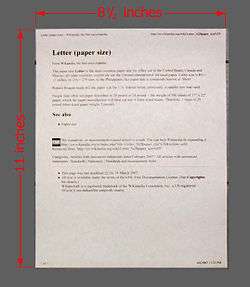Letter (paper size)
Letter or ANSI Letter is a paper size commonly used as home or office stationery in the United States, Canada, Chile, Colombia, Costa Rica, Mexico, Panama, the Dominican Republic and the Philippines. It measures 8.5 by 11 inches (215.9 by 279.4 mm). US Letter-size paper is a standard defined by the American National Standards Institute (ANSI, paper size A), in contrast to A4 paper used by most other countries, and adopted at varying dates, which is defined by the International Organization for Standardization, specifically in ISO 216.


Details
The Reagan administration made Letter-size paper the norm for U.S. federal forms in the early 1980s; previously, the smaller "official" Government Letter size, 8 by 10.5 inches (203.2 by 266.7 mm) (aspect ratio: 1.3125), was used in government, while 8.5-by-11-inch (215.9 by 279.4 mm) paper was standard in most other offices.[1] The aspect ratio is ≈1.294 and the diagonal is ≈13.901 () in length.
In the U.S., paper density is usually measured in "pounds per ream" (of 500 sheets). Typical Letter paper has a basis weight of paper of 20 or 24 pounds (9.1 or 10.9 kg) – the weight of 500 sheets (a ream) of 17-by-22-inch (431.8 by 558.8 mm) paper at 70 °F (21 °C) and at 50% humidity.[2] One ream of 20-pound Letter-sized paper weighs 5 pounds (2.3 kg), and a single Letter-sized sheet of 20-pound paper weighs 0.16 ounces (4.536 g), which is equivalent to 75.19 g/m2. Some metric information is typically included on American ream packaging. For example, 20-pound paper is also labeled as 75 g/m2. The most common density of A4 paper is 80 g/m2.
The precise origins of the dimensions of US letter-size paper (8.5 × 11 in) are not known. The American Forest & Paper Association says that the standard US dimensions have their origin in the days of manual paper making, the 11" length of the standard paper being about a quarter of "the average maximum stretch of an experienced vatman's arms".[1] The letter size falls within the range of the historical quarto size, which since pre-modern times refers to page sizes of 8 to 9 inches (200 to 230 mm) wide and 10 to 11 inches (250 to 280 mm) high, and it is indeed almost exactly one quarter of the old Imperial (British) paper size known as Demy 4to - 17 1⁄2 by 22 1⁄2 inches (440 by 570 mm) - allowing a 1⁄2 inch (13 mm) for trimming.[3]
The related paper size known as half letter, statement, or organizer L is exactly one half of the US Letter size: 8.5 by 5.5 inches (215.9 by 139.7 mm) (8.5 × 5.5 in).
See also
- ANSI/ASME Y14.1
- ISO 216 (definition of metric paper sizes, e.g., A4)
- Paper size: loose sizes
Notes
- American Forest and Paper Association. "Why is the standard paper size in the U.S. 8 ½" x 11"?". Archived from the original on February 20, 2012. Retrieved 2014-02-20.
- Blocksma, Mary. Reading the Numbers. New York: Penguin Books, 1989.
- Fyffe, Charles (1969). Basic Copyfitting. London: Studio Vista. p. 74. ISBN 0-289-79705-5.